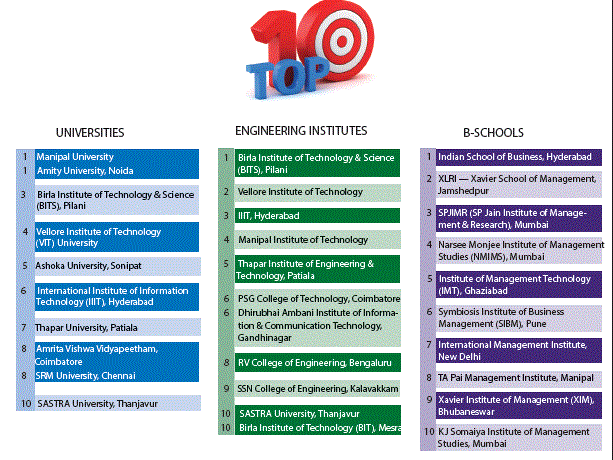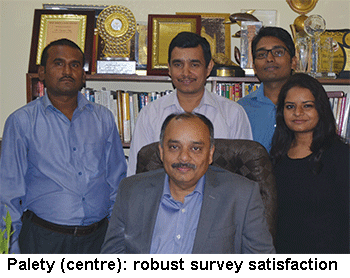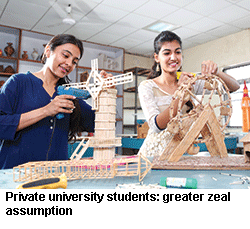Within the media and the public, there’s little awareness that the country’s 266 private universities, 2,415 B-schools and 2,776 engineering institutes provide good, bad and indifferent education to 65 percent of the country’s 29 million youth in higher education - Dilip Thakore
 As usual, publication of the annual EducationWorld Top 100 private universities, private engineering colleges and B-schools summer league tables has been preceded by the Union human resource development ministry’s National Institutional Ranking Framework (NIRF) 2017 which ranks government and private universities, colleges and professional colleges (engineering, business management, pharmacy). NIRF 2017 was released by Union HRD minister Prakash Javadekar in New Delhi on April 3 with heavily subsidised Central government universities — the Indian Institute of Science, Bangalore, Jawaharlal Nehru University, Delhi, Benares Hindu, Jadavpur (Kolkata) and Delhi universities — dominating the separate ‘overall’ and ‘universities’ league tables. Surprisingly, India’s top-ranked private university in the NIRF 2017 is the Coimbatore-based Amrita Vishwa Vidyapeetham, ranked #9.
As usual, publication of the annual EducationWorld Top 100 private universities, private engineering colleges and B-schools summer league tables has been preceded by the Union human resource development ministry’s National Institutional Ranking Framework (NIRF) 2017 which ranks government and private universities, colleges and professional colleges (engineering, business management, pharmacy). NIRF 2017 was released by Union HRD minister Prakash Javadekar in New Delhi on April 3 with heavily subsidised Central government universities — the Indian Institute of Science, Bangalore, Jawaharlal Nehru University, Delhi, Benares Hindu, Jadavpur (Kolkata) and Delhi universities — dominating the separate ‘overall’ and ‘universities’ league tables. Surprisingly, India’s top-ranked private university in the NIRF 2017 is the Coimbatore-based Amrita Vishwa Vidyapeetham, ranked #9.
Although widely welcomed, the annual NIRF league tables have been compiled in typically slipshod government style. For one, ‘participation’ is voluntary with participating universities required to furnish extensive documentation. Consequently several reputed institutions such as St. Stephen’s College, Delhi, Christ University, Bangalore, and Mumbai University among others, are not in the NIRF league table of Top 100 universities. Secondly and perhaps more importantly, despite the huge resources of the Central government to check and cross-check submitted data, this obligation is neglected with the result that NIRF 2017 stretches public credulity.
For instance in NIRF 2017, the almost unknown Savitribai Phule University, Pune at #11 is ranked above the highly-reputed Birla Institute of Technology & Science, Pilani, Delhi’s Jamia Millia Islamia, VIT University, Vellore, and Manipal University. Curiously, although the latter was conferred deemed university status and renamed in 1993, it is described as the Manipal Academy of Higher Education in NIRF 2017. Moreover, Tezpur University whose #5 ranking last year aroused derisive media and academia comment is relegated to #30 this year, but still above the highly-reputed Tata Institute of Social Sciences (estb. 1936), and the massively advertised Amity University with 150,000 students in ten campuses in India and eight abroad — including a recently inaugurated 170-acre campus in the US — which is ranked #52 in NIRF 2017. Another shocking omission is the newly-established (2014) uniquely crowd-funded, new genre liberal arts Ashoka University, Sonipat (Delhi NCR), equipped with a star-studded, internationally-recruited faculty which attracted eight admission applications for every available seat in 2016.
On the other hand in the EducationWorld India Top 100 Private University Rankings 2017-18, Manipal and Amity universities are jointly ranked #1 and BITS, Pilani, and VIT are ranked among the Top 5, while Ashoka University has vaulted from #9 last year to #5. Even after making allowances for the deep prejudice of the left-liberal establishment against private universities and institutions, the low ranking awarded to these superbly-equipped and well-managed private universities with faculty from around the world, stretches the credulity, exposes gross negligence and brings the NIRF 2017 into disrepute, if not contempt.
Ex facie the HRD ministry’s NIRF league tables seem superior to the mainly perceptual ratings and rankings of mainstream media publications, including EducationWorld. Government propaganda projects NIRF as heavily data mined and based on objective facts. But it’s pertinent to note that the facts and data (including public perception) are submitted by participating universities. In effect despite its vast resources, the Central government/ HRD ministry, exhibiting typical official inertia, has made no effort to study the books of participating institutions, or gather data from independent sources to compile the NIRF league tables. Even ‘perception details’, including peer, employer and public perception, are required to be submitted by participating institutions.
The inherent danger of transferring the entire burden of data collection, compilation and submission to participating institutions is tacitly acknowledged by the HRD ministry and authors of NIRF 2017. The following disclaimer is appended to the data sheet submitted by participant institutions and published as a PDF attachment in the NIRF league tables: “Responsibility for the accuracy and authenticity of data files with concerned institution.”
Mainstream media is also guilty of failing to sufficiently scrutinise the lazy evaluation NIRF process and methodology, resulting in these flawed official league tables making headlines across the country. As in academia, so in the media, there is quick and unquestioning acceptance of official studies and documents as holy writ. Even within the community of well-informed monitors of the crumbling education system, there’s discernible reluctance to criticise the NIRF Rankings in the hope that the assessment process will improve with the passage of time. However, there’s rising discomfort within the small community of bona fide educationists with the patent bias in the NIRF league tables against the country’s increasingly popular private universities and higher education institutions, which have emerged as the next-best options to Central universities and colleges, which provide acceptable quality education at heavily subsidised prices.
 But within the media and public, there’s little awareness that the country’s 266 private universities, 2,415 B-schools and 2,776 engineering colleges provide good, bad and indifferent quality tertiary education to the majority (65 percent) of the country’s 29 million youth in higher education. Therefore the casual, off-hand dismissal of even the best private universities and colleges to the nether reaches of the NIRF tables is a disservice to the promoters and faculty of new genre private universities as also to the public, which is likely to be misguided by the NIRF league tables.
But within the media and public, there’s little awareness that the country’s 266 private universities, 2,415 B-schools and 2,776 engineering colleges provide good, bad and indifferent quality tertiary education to the majority (65 percent) of the country’s 29 million youth in higher education. Therefore the casual, off-hand dismissal of even the best private universities and colleges to the nether reaches of the NIRF tables is a disservice to the promoters and faculty of new genre private universities as also to the public, which is likely to be misguided by the NIRF league tables.
There is undoubtedly an ideological bias in Indian society against ‘profiting from education’ that finds its way into government policies resulting in over-regulation of private schools and higher education institutions. The plain truth is that India cannot afford the luxury of such prejudice. We need all types of institutions: public, private, for-profit and non-profit to provide adequate quantity and quality education to our population. Forcing higher education institutions to pretend to be non-profit is hypocrisy from our socialist past that India cannot afford. The quality of education doesn’t depend on whether an institution is managed by the government or is privately promoted. As the great Chinese statesman and reformer Deng Xiaoping famously observed, it doesn’t matter if a cat is black or white, as long as it catches mice,” says Dr. Nitin Pai, an alum of Nanyang Technological University and Lee Kuan Yew School of Public Policy, Singapore, and founder-director of the Takshashila Foundation (estb. 2009), a Bangalore-based think tank.
 Therefore, mindful of the important but unacknowledged role of privately-promoted institutions of higher education within the Indian economy, last year your editors took a considered decision to abjure the standard media (and government) practice of ranking all — public and private — universities, B-schools and engineering colleges in composite league tables. Given that government higher education institutions across the board are highly subsidised and students’ tuition fees are a fraction of the actual cost of education provision, whereas in privately-promoted universities and colleges they are market-driven or cost-plus, and therefore substantially higher, lumping them together for purposes of evaluation is tantamount to comparing apples and oranges.
Therefore, mindful of the important but unacknowledged role of privately-promoted institutions of higher education within the Indian economy, last year your editors took a considered decision to abjure the standard media (and government) practice of ranking all — public and private — universities, B-schools and engineering colleges in composite league tables. Given that government higher education institutions across the board are highly subsidised and students’ tuition fees are a fraction of the actual cost of education provision, whereas in privately-promoted universities and colleges they are market-driven or cost-plus, and therefore substantially higher, lumping them together for purposes of evaluation is tantamount to comparing apples and oranges.
Quite obviously, a household choosing a private university or college is making a serious financial decision, and as such is entitled to know how private institutions compare inter se on various parameters — competence of faculty, research, infrastructure, industry placements etc — of education excellence. It’s also arguable that because of universal subsidisation of tuition fees in government varsities and colleges, academics and students tend to be casual about teaching-learning. On the other hand, it’s logical to assume that faculty and students in full-fees charging private education institutions are more zealous about delivering and deriving full value.
Although comfortably tenured left-liberal academics in public universities dispensing recycled old knowledge, and ill-informed mainstream media pundits are in denial, there’s no doubt about a growing consensus within middle class India that globally benchmarked private universities such as Manipal, Amity, Ashoka, O.P Jindal, SRM, VIT, Bennett among others, are a far better bet for qualitatively meaningful tertiary education than all except a few dozen Central government universities and older IITs and IIMs.
“India’s best older private universities such as Manipal, VIT, SRM, M.S. Ramaiah and newer varsities such as Amity, Azim Premji, Shiv Nadar, O.P Jindal, B.M. Munjal and Ashoka, have great potential to develop into American Ivy league-style institutions of higher education. All of them are globally — rather than locally — benchmarked, generously funded, attract highly-qualified faculty from around the world, have set themselves high standards of teaching and research and deliver exceptional service at very affordable — by global standards — tuition fees. Already their alumni are sought after by industry and their placements are excellent. Moreover, many of them have carefully separated their management and academic functions — rare in Indian education — and have exhibited excellent project implementation skills. The best private universities have the potential to make great contribution to raising standards in higher education. Therefore they should be given full official and societal support and encouragement,” says Narayan Ramaswamy, the Chennai-based partner and head (South Asia) of the education and skills development division of KPMG, the well-known US-based business consultancy and audit transnational corporation. An alum of the Thiagarajar College of Engineering, Madurai and IIM-Bangalore, Ramaswamy acquired valuable experience in CMC, Price Waterhouse Cooper and Arthur Andersen prior to signing up with KPMG in 2003.
Against this backdrop of the rising importance of private universities, B-schools and engineering colleges in Indian higher education, in a departure from standard practice, your editors commissioned the Centre for Forecasting & Research Pvt. Ltd (C fore, estb. 2000), the well-reputed Delhi-based market research and opinion polls company, to constitute separate sample databases of knowledgeable faculty, final year students and industry representatives to rate and rank India’s Top 100 private universities, engineering institutes and B-schools from a shortlist provided by your editors.
Thereafter over 200 C fore field personnel fanned out across the country and persuaded 2.133 faculty, 1,368 final year students from 164 universities as also 964 industry representatives to rate the Top 100 private universities on ten parameters of education excellence. The scores awarded by the sample respondents on each parameter were totalled to rank private varsities inter se. However to introduce an objective perspective into this mainly perceptual exercise (although the sample respondents are highly knowle dgeable), on the vital parameter of research and innovation awarded the highest weightage of 300, the varsities were rated on the basis of their faculties’ citations in refereed journals.
dgeable), on the vital parameter of research and innovation awarded the highest weightage of 300, the varsities were rated on the basis of their faculties’ citations in refereed journals.
“A great deal of planning and coordination has been invested in compiling the league tables of the EducationWorld India Private University Rankings 2017-18,” says Premchand Palety, the promoter-CEO of C fore whose clients include Mint, NDTV and the public sector Indian Oil Corp. “The perceptual data was collected using a structured questionnaire which was administered to sample respondents in 25 cities countrywide. Moreover, on the important parameter of research  and innovation capability, the rating was calculated for every university by the total number of citations divided by the number of refereed journals approved by Scopus and the Web of Science index. I am satisfied that we have conducted a robust survey, accurately reflecting the higher education capabilities of India’s Top 100 private universities, engineering institutes and Top 50 B-schools, presented in the EW India Private Higher Education Rankings 2017-18,” adds Palety.
and innovation capability, the rating was calculated for every university by the total number of citations divided by the number of refereed journals approved by Scopus and the Web of Science index. I am satisfied that we have conducted a robust survey, accurately reflecting the higher education capabilities of India’s Top 100 private universities, engineering institutes and Top 50 B-schools, presented in the EW India Private Higher Education Rankings 2017-18,” adds Palety.
Brief commentaries followed by league tables of India’s Top 100 private universities, Top 100 private engineering institutes and Top 50 B-schools are set out over the next 45 pages.
For EW India Private Higher Education Rankings 2017-18 tables, please visit: